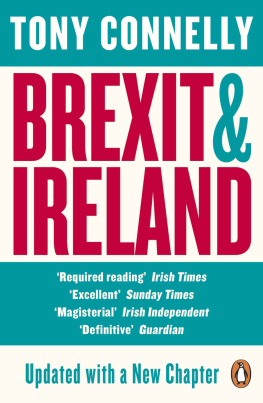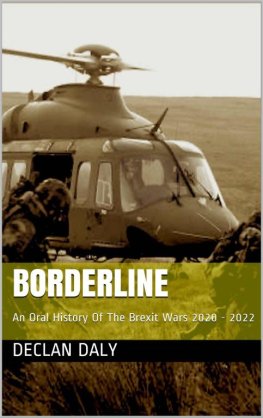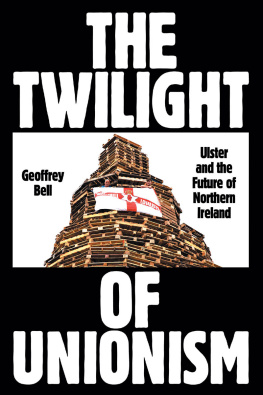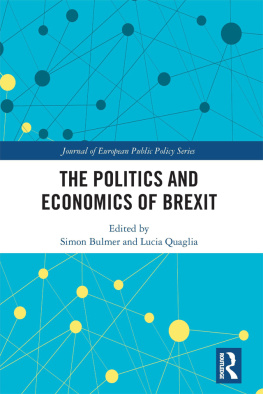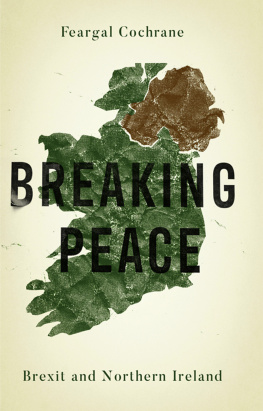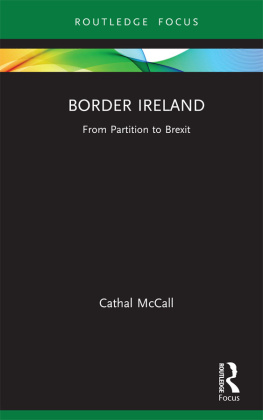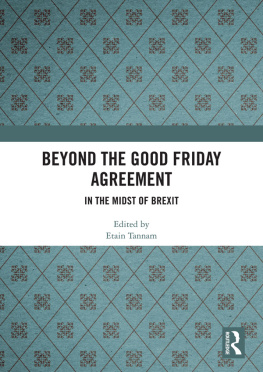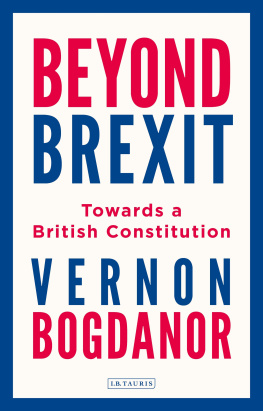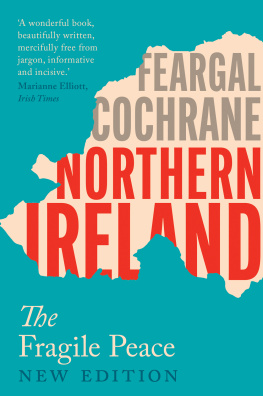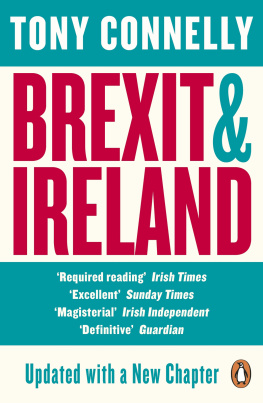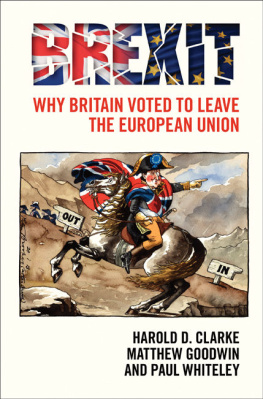Tony Connelly
BREXIT AND IRELAND
The Dangers, the Opportunities, and the Inside Story of the Irish Response
Contents
PENGUIN BOOKS
BREXIT AND IRELAND
Tony Connelly has been reporting on Europe for RT since 2001, firstly as Europe Correspondent, and more recently as Europe Editor. He lives in Brussels.
For Jack and Rikke
A fatal space had opened, like that between a liner and the dock which is suddenly too wide to leap; everything is still present, visible, but it cannot be regained.
James Salter, Light Years
I distrust anyone who foresees consequences and advocates remedies to avert them.
Lord Halifax, British Foreign Secretary (193840)
1. What Just Happened?
On the night of 23 June 2016, the mood in Number 10 was buoyant. Thirty-three million people had just voted in the referendum on whether the United Kingdom should remain in the European Union, or leave. Last-minute polling pointed to a narrow victory for Remain.
The drinks were flowing. In anticipation of some celebratory dancing, someone had curated a playlist around the theme of belonging. There was Rick Astleys Never Gonna Give You Up, the Human Leagues Dont You Want Me Baby? and Dont Look Back in Anger by Oasis. Should I Stay or Should I Go? by the Clash, Will Youngs Leave Right Now and East 17s Stay Another Day were added to the mix. After months of gruelling preparation, who would deny hard-working civil servants some musical irony?
This was not, it should be noted, Number 10 Downing Street. This Number 10 was the bar on the ground floor of the UKs embassy complex in Brussels. Officially called the UK Representation to the European Union, but most commonly referred to as UKRep, it has since 2009 occupied a formidable Art Deco building just off the Schuman roundabout in the so-called European quarter. Diagonally across the roundabout is the hulking cruciform of the European Commission the seat of the hated EU bureaucracy, according to Brexit lore. Beyond, a parade of restaurants, cafs and bars refreshes a daily swarm of officials, lobbyists, journalists and politicians. In the Funky Monkey, an Irish watering hole, journalists, lobbyists and EU officials had gathered for a party of their own. UKRep staff had also been invited, but most felt uncomfortable about drinking in the presence of journalists while an existential referendum was in the balance.
One senior British member of the European Commission did drop in. People were nervous and chatting away, he recalls. The general view from the hacks, which they were getting from their desks in London, was: watch out for Sunderland. If Newcastle and Sunderland are close, then its very bad news for the Remain campaign. If they are lost, then its all over.
Outside, there was an eerie mood of expectation and foreboding. There had been a heavy thunderstorm all evening. It was a night of huge rainstorms, recalls the British Commission official. There was a weird orange sky. It was all very apocalyptic. It was something like a bad production of Shakespeare.
UKRep has around 170 staff, including 100 policy experts. They are all British civil servants, seconded to Brussels or hired locally. The Ambassador himself, Sir Ivan Rogers, opened the bar. Number 10 is more sixth-form caf than gentlemens club. But Rogers and his number two, Shan Morgan, were determined to get the drinks in early. The polls would close at 10 p.m. British time. A hard core would stay all night.
One thousand kilometres to the west, another, more sober operation was under way in Government Buildings on Merrion Street in Dublin. This was not an Irish referendum, but it might as well have been. Officials from virtually every government department had been tasked with drawing up detailed explorations of how a Leave vote might affect Ireland. The first task, whatever the result, was to communicate a clear Irish response.
As voters were going to the polls in the UK, most of the Irish team had tried to get home early. The plan was to get some sleep and reconvene at Government Buildings at 3 a.m. A camaraderie among the core officials had built up over time, and they wanted to share the experience of referendum night. Two rooms had been kitted out just below the landmark dome on the top floor of the government complex. Room 301 is the smaller, discreet, oak-panelled room that had been reserved for conference calls or any impromptu meetings that might be needed between senior officials, decision-makers and principal officers. Room 308, a larger, yellow-hued and more functional room, was the main hub for staff to work and to watch the results. Tables had been removed and sofas were commandeered from throughout the building. Large screens beamed Sky News and the BBC; a Twitter wall was mounted so that officials could assess reaction across social media. An IT unit was on call from 3 a.m. in case of technical glitches. There was tea and coffee in the kitchen next door; unlike at Number 10, there was no alcohol. A quick ring around earlier in the day had established where pizza might be sourced from 3 a.m.
There had been intense preparations in Dublin in the final weeks of the referendum campaign. There was one fundamental imperative: if Britain voted to leave the EU, the Irish state would have to show its citizens and the world that it could withstand the immediate impact and that, no matter what, Ireland would be remaining in the EU. From 7 June, officials had determined where ministers would be, built web pages, prepared press notes, and briefed media advisers and Irish embassies abroad. A stakeholders group, involving bodies like ICTU, IBEC and the European Movement Ireland, and that had been meeting for several months, was contacted in the final week to ensure that messaging would be streamlined. The 12-strong Cabinet Subcommittee on the EU, chaired by the Taoiseach, Enda Kenny, and comprising 11 senior ministers, would have to sign off on the preparations and finalize speeches. On Monday, three days before the vote, the switchboard was warned to expect an increased number of calls. Callers were to be directed to an online consumer friendly fact sheet on what would happen next.
On the eve of the vote, the main referendum team met in Room 308. They included Rory Montgomery, a former Irish Ambassador to the EU and now the Second Secretary General in the Department of Foreign Affairs, and at least 12 other officials from the departments of the Taoiseach and Foreign Affairs. They had war-gamed three scenarios: a clear Leave result at 5 a.m.; a clear Remain result; and an unclear result. Each scenario required five essential elements: a schedule of what would happen on the day; how to manage the media response; what press releases would be issued by government departments and agencies and when; what documents would be circulated; and how the government should engage with stakeholders at home and abroad.
The document for the Leave scenario was much thicker than that for Remain. There was an hour-by-hour schedule, beginning with stock-market reactions. There would be a holding statement from the government ready to go at 6 a.m. By 7 a.m. Irish officials in London, Belfast, Brussels and Edinburgh would hold video conferences just as the Frankfurt stock market was opening. At 7.15 a.m. the Taoiseach would phone EU leaders and leaders of the opposition (if necessary). An emergency Cabinet meeting would take place shortly afterwards. A WhatsApp text-message group was set up comprising the communications operatives from each government department and from state agencies, and any other officials who needed to be in the loop.

